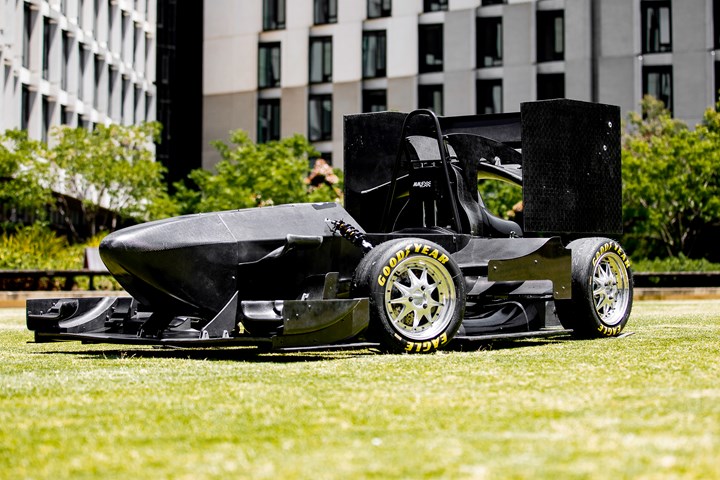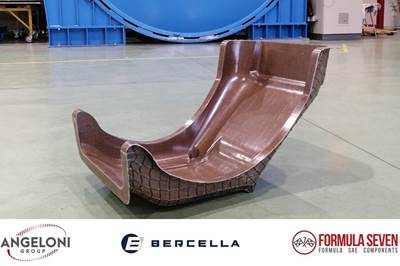Monash Motorsport constructs FSAE autonomous, electric vehicle with ATL Composites materials
Composite are incorporated into the vehicle’s monocoque chassis, aerofoils, aerofoil endplates and other components to suit high aerodynamic loads, minimize mass and enhance efficiency for the globally competitive team.
As creativity and construction are revving up at Monash Motorsport, a student-run team in Clayton, Australia, who compete in some of the world’s largest engineering design competitions in vehicle design, ATL Composites (Molendinar, Australia) has become an important contributor of its composite products for the team’s ground-breaking designs, delivering strength, durability, a lightweight structure and high performance.
The Monash Motorsport team of close to 100 members is comprised of Monash University students from a range of faculties, including engineering, commerce, science, design and law. They are split into five separate departments working on different parts of the car including autonomous systems, business, dynamics, electrical systems and structures.
Since 2000, Monash Motorsport has steadily improved in performance on and off the track, culminated in FSAE Australasia and in European Formula Student competitions. The team has also developed what is reported to be Australia’s first competition-ready Formula Student Driverless car. Their sights are currently set on the top of the Driverless class of this year’s next competition, FSAE-Australasia, occurring in December 2022 at Winton Raceway.
“We are also working towards competing in Europe in 2023 at various Formula Student competitions there,” Michaela Sykes-Turner, head of business for Monash Motorsports, says. “In Europe there are a large number of different FSAE competitions each in a different country, so it would be a great opportunity for the team to gain competition experience, see different design ideas and showcase Australian engineering on a world stage.”
Crucial to the team’s current vehicle’s lightweight yet sturdy construction is ATL Composites’ range of products including twill weave carbon fiber, Kinetix R118 infusion resin and H126 hardener, infusion tubing and Divinycell H60 foam in various thicknesses.
“They are using the carbon [fiber], resin and core materials for the manufacture of their aerodynamics package, which may include the aerofoils, aerofoil endplates and their undertray and various flow conditioning devices,” Justin McDermott, technical engineer at ATL, notes. “Kinetix R118 infusion resin is ideal for their purpose due to the low viscosity, allowing for easy infusion and great mechanical properties, with the hardener providing good mechanical properties with a short manufacturing time. This, in combination with our carbon [fiber] products and Divinycell PVC core, allows for a strong, lightweight construction of aerodynamic components that suit the high aerodynamic loads these FSAE vehicles experience.”
The Monash Motorsports teams have competed each year in the Australian FSAE and have competed overseas in Europe every two years.
“In Europe we often compete at FSUK [Formula Student UK], FSA [Formula Student Austria] and the largest and most prestigious competition, FSG [Formula Student Germany],” Sykes-Turner says. “Over our 20-year history we have worked our way up the world ranking, with 2018 Europe and 2019 Australian competition results putting us at first in the world for combustion and third in the world for electric vehicle racing. Since then, we retired our combustion car to focus entirely on electric and autonomous vehicle racing.”
According to Sykes-Turner, FSAE competitions distribute a new rule set each year, consisting of up to 200 pages of detailed design parameters.
“An example of some of our rules are rule boxes, where you can design anything you want within that box,” she notes. “For example, our aerodynamics package must fit into a set of rule boxes defined in the rule book, or the power rule that states we cannot draw more than 80 kilowatts of power from our accumulator — the main battery pack of the vehicle.”
Vehicles, too, are judged on their performance. “This means designing for minimum mass, greatest downforce, maximum efficiency and more,” Sykes-Turner says. “This is why we contacted ATL composites, because using lightweight carbon fiber composites means we can minimize the mass of our vehicle while still abiding by the strength requirements defined by rules.
“While we aren't allowed to increase power over 80 kilowatts, decreasing mass will help our car to drive and accelerate faster with more efficiency. We use carbon fiber for the entirety of our aerodynamics package, as well as the monocoque chassis of our car since it has such great material properties. [Specifically] with ATL products, we can use high-quality carbon fiber, infuse it with resin for strength and use lightweight foam interior for minimal mass.”
The team’s current vehicle is their most ambitious yet, according to Monash Motorsport. Named M22, it will be their first all-wheel drive car with outboard motors and custom gearboxes in each wheel. Sykes-Turner says it is designed to maximise downforce, with a more aggressive aerodynamics design than previous years. The team is also working on custom motors to replace the team’s off-the-shelf motors being used currently, which would go with a custom inverter design being worked on.
“This is the vehicle we will compete with at the Australian competition at the end of the year, and hopefully in Europe in 2023,” she points out. “We are also working on getting the autonomous systems reliably on the car, so that we can compete in autonomous competition in Europe next year.”
Related Content
Carbon fiber, bionic design achieve peak performance in race-ready production vehicle
Porsche worked with Action Composites to design and manufacture an innovative carbon fiber safety cage option to lightweight one of its series race vehicles, built in a one-shot compression molding process.
Read MoreCutting 100 pounds, certification time for the X-59 nose cone
Swift Engineering used HyperX software to remove 100 pounds from 38-foot graphite/epoxy cored nose cone for X-59 supersonic aircraft.
Read MoreAn outlook on China’s carbon fiber market
This analysis sheds additional light on the insights, observations and data shared in ATA Industrial Group’s carbon fiber market report on global and Chinese industry players.
Read MoreCarbon fiber composite pallet revolutionizes freight industry
LOG Point Pallet fuses advanced materials with innovative design and manufacturing to improve supply chains worldwide.
Read MoreRead Next
Two-time F1 champion Fernando Alonso, SimplyEV debut Kimoa e-bike at Miami Grand Prix
The Formula One driver’s sustainable mobility Kimoa brand is debuting its fully customizable carbon fiber e-bike powered by 3D printing firm Arevo.
Read MoreBercella, Formula Seven target motorsport innovation with natural fiber composite developments
AmpliTex flax fiber used to develop Formula SAE single-seater racing seat for better resistance, vibration absorption and reduced environmental impact.
Read MoreCutting 100 pounds, certification time for the X-59 nose cone
Swift Engineering used HyperX software to remove 100 pounds from 38-foot graphite/epoxy cored nose cone for X-59 supersonic aircraft.
Read More




























